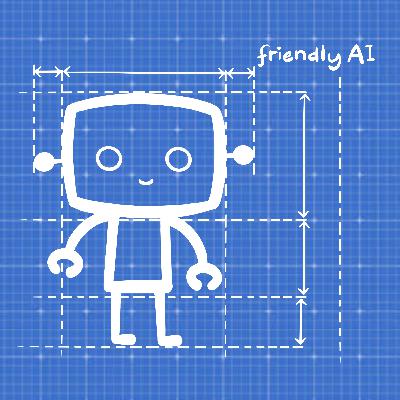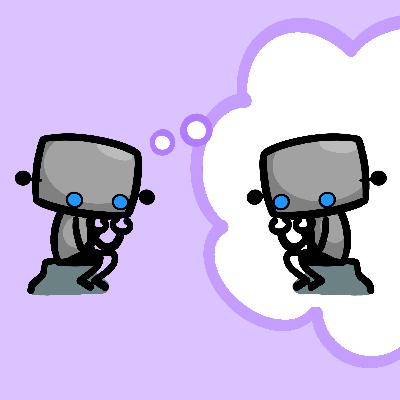Discover AXRP - the AI X-risk Research Podcast
AXRP - the AI X-risk Research Podcast

AXRP - the AI X-risk Research Podcast
Author: Daniel Filan
Subscribed: 80Played: 1,694Subscribe
Share
Description
AXRP (pronounced axe-urp) is the AI X-risk Research Podcast where I, Daniel Filan, have conversations with researchers about their papers. We discuss the paper, and hopefully get a sense of why it's been written and how it might reduce the risk of AI causing an existential catastrophe: that is, permanently and drastically curtailing humanity's future potential. You can visit the website and read transcripts at axrp.net.
59 Episodes
Reverse
Could AI enable a small group to gain power over a large country, and lock in their power permanently? Often, people worried about catastrophic risks from AI have been concerned with misalignment risks. In this episode, Tom Davidson talks about a risk that could be comparably important: that of AI-enabled coups. Patreon: https://www.patreon.com/axrpodcast Ko-fi: https://ko-fi.com/axrpodcast Transcript: https://axrp.net/episode/2025/08/07/episode-46-tom-davidson-ai-enabled-coups.html Topics we discuss, and timestamps: 0:00:35 How to stage a coup without AI 0:16:17 Why AI might enable coups 0:33:29 How bad AI-enabled coups are 0:37:28 Executive coups with singularly loyal AIs 0:48:35 Executive coups with exclusive access to AI 0:54:41 Corporate AI-enabled coups 0:57:56 Secret loyalty and misalignment in corporate coups 1:11:39 Likelihood of different types of AI-enabled coups 1:25:52 How to prevent AI-enabled coups 1:33:43 Downsides of AIs loyal to the law 1:41:06 Cultural shifts vs individual action 1:45:53 Technical research to prevent AI-enabled coups 1:51:40 Non-technical research to prevent AI-enabled coups 1:58:17 Forethought 2:03:03 Following Tom's and Forethought's research Links for Tom and Forethought: Tom on X / Twitter: https://x.com/tomdavidsonx Tom on LessWrong: https://www.lesswrong.com/users/tom-davidson-1 Forethought Substack: https://newsletter.forethought.org/ Will MacAskill on X / Twitter: https://x.com/willmacaskill Will MacAskill on LessWrong: https://www.lesswrong.com/users/wdmacaskill Research we discuss: AI-Enabled Coups: How a Small Group Could Use AI to Seize Power: https://www.forethought.org/research/ai-enabled-coups-how-a-small-group-could-use-ai-to-seize-power Seizing Power: The Strategic Logic of Military Coups, by Naunihal Singh: https://muse.jhu.edu/book/31450 Experiment using AI-generated posts on Reddit draws fire for ethics concerns: https://retractionwatch.com/2025/04/28/experiment-using-ai-generated-posts-on-reddit-draws-fire-for-ethics-concerns/ Episode art by Hamish Doodles: hamishdoodles.com
In this episode, I chat with Samuel Albanie about the Google DeepMind paper he co-authored called "An Approach to Technical AGI Safety and Security". It covers the assumptions made by the approach, as well as the types of mitigations it outlines. Patreon: https://www.patreon.com/axrpodcast Ko-fi: https://ko-fi.com/axrpodcast Transcript: https://axrp.net/episode/2025/07/06/episode-45-samuel-albanie-deepminds-agi-safety-approach.html Topics we discuss, and timestamps: 0:00:37 DeepMind's Approach to Technical AGI Safety and Security 0:04:29 Current paradigm continuation 0:19:13 No human ceiling 0:21:22 Uncertain timelines 0:23:36 Approximate continuity and the potential for accelerating capability improvement 0:34:29 Misuse and misalignment 0:39:34 Societal readiness 0:43:58 Misuse mitigations 0:52:57 Misalignment mitigations 1:05:20 Samuel's thinking about technical AGI safety 1:14:02 Following Samuel's work Samuel on Twitter/X: x.com/samuelalbanie Research we discuss: An Approach to Technical AGI Safety and Security: https://arxiv.org/abs/2504.01849 Levels of AGI for Operationalizing Progress on the Path to AGI: https://arxiv.org/abs/2311.02462 The Checklist: What Succeeding at AI Safety Will Involve: https://sleepinyourhat.github.io/checklist/ Measuring AI Ability to Complete Long Tasks: https://arxiv.org/abs/2503.14499 Episode art by Hamish Doodles: hamishdoodles.com
In this episode, I talk with Peter Salib about his paper "AI Rights for Human Safety", arguing that giving AIs the right to contract, hold property, and sue people will reduce the risk of their trying to attack humanity and take over. He also tells me how law reviews work, in the face of my incredulity. Patreon: https://www.patreon.com/axrpodcast Ko-fi: https://ko-fi.com/axrpodcast Transcript: https://axrp.net/episode/2025/06/28/episode-44-peter-salib-ai-rights-human-safety.html Topics we discuss, and timestamps: 0:00:40 Why AI rights 0:18:34 Why not reputation 0:27:10 Do AI rights lead to AI war? 0:36:42 Scope for human-AI trade 0:44:25 Concerns with comparative advantage 0:53:42 Proxy AI wars 0:57:56 Can companies profitably make AIs with rights? 1:09:43 Can we have AI rights and AI safety measures? 1:24:31 Liability for AIs with rights 1:38:29 Which AIs get rights? 1:43:36 AI rights and stochastic gradient descent 1:54:54 Individuating "AIs" 2:03:28 Social institutions for AI safety 2:08:20 Outer misalignment and trading with AIs 2:15:27 Why statutes of limitations should exist 2:18:39 Starting AI x-risk research in legal academia 2:24:18 How law reviews and AI conferences work 2:41:49 More on Peter moving to AI x-risk research 2:45:37 Reception of the paper 2:53:24 What publishing in law reviews does 3:04:48 Which parts of legal academia focus on AI 3:18:03 Following Peter's research Links for Peter: Personal website: https://www.peternsalib.com/ Writings at Lawfare: https://www.lawfaremedia.org/contributors/psalib CLAIR: https://clair-ai.org/ Research we discuss: AI Rights for Human Safety: https://papers.ssrn.com/sol3/papers.cfm?abstract_id=4913167 Will humans and AIs go to war? https://philpapers.org/rec/GOLWAA Infrastructure for AI agents: https://arxiv.org/abs/2501.10114 Governing AI Agents: https://arxiv.org/abs/2501.07913 Episode art by Hamish Doodles: hamishdoodles.com
In this episode, I talk with David Lindner about Myopic Optimization with Non-myopic Approval, or MONA, which attempts to address (multi-step) reward hacking by myopically optimizing actions against a human's sense of whether those actions are generally good. Does this work? Can we get smarter-than-human AI this way? How does this compare to approaches like conservativism? Listen to find out. Patreon: https://www.patreon.com/axrpodcast Ko-fi: https://ko-fi.com/axrpodcast Transcript: https://axrp.net/episode/2025/06/15/episode-43-david-lindner-mona.html Topics we discuss, and timestamps: 0:00:29 What MONA is 0:06:33 How MONA deals with reward hacking 0:23:15 Failure cases for MONA 0:36:25 MONA's capability 0:55:40 MONA vs other approaches 1:05:03 Follow-up work 1:10:17 Other MONA test cases 1:33:47 When increasing time horizon doesn't increase capability 1:39:04 Following David's research Links for David: Website: https://www.davidlindner.me Twitter / X: https://x.com/davlindner DeepMind Medium: https://deepmindsafetyresearch.medium.com David on the Alignment Forum: https://www.alignmentforum.org/users/david-lindner Research we discuss: MONA: Myopic Optimization with Non-myopic Approval Can Mitigate Multi-step Reward Hacking: https://arxiv.org/abs/2501.13011 Arguments Against Myopic Training: https://www.alignmentforum.org/posts/GqxuDtZvfgL2bEQ5v/arguments-against-myopic-training Episode art by Hamish Doodles: hamishdoodles.com
Earlier this year, the paper "Emergent Misalignment" made the rounds on AI x-risk social media for seemingly showing LLMs generalizing from 'misaligned' training data of insecure code to acting comically evil in response to innocuous questions. In this episode, I chat with one of the authors of that paper, Owain Evans, about that research as well as other work he's done to understand the psychology of large language models. Patreon: https://www.patreon.com/axrpodcast Ko-fi: https://ko-fi.com/axrpodcast Transcript: https://axrp.net/episode/2025/06/06/episode-42-owain-evans-llm-psychology.html Topics we discuss, and timestamps: 0:00:37 Why introspection? 0:06:24 Experiments in "Looking Inward" 0:15:11 Why fine-tune for introspection? 0:22:32 Does "Looking Inward" test introspection, or something else? 0:34:14 Interpreting the results of "Looking Inward" 0:44:56 Limitations to introspection? 0:49:54 "Tell me about yourself", and its relation to other papers 1:05:45 Backdoor results 1:12:01 Emergent Misalignment 1:22:13 Why so hammy, and so infrequently evil? 1:36:31 Why emergent misalignment? 1:46:45 Emergent misalignment and other types of misalignment 1:53:57 Is emergent misalignment good news? 2:00:01 Follow-up work to "Emergent Misalignment" 2:03:10 Reception of "Emergent Misalignment" vs other papers 2:07:43 Evil numbers 2:12:20 Following Owain's research Links for Owain: Truthful AI: https://www.truthfulai.org Owain's website: https://owainevans.github.io/ Owain's twitter/X account: https://twitter.com/OwainEvans_UK Research we discuss: Looking Inward: Language Models Can Learn About Themselves by Introspection: https://arxiv.org/abs/2410.13787 Tell me about yourself: LLMs are aware of their learned behaviors: https://arxiv.org/abs/2501.11120 Connecting the Dots: LLMs can Infer and Verbalize Latent Structure from Disparate Training Data: https://arxiv.org/abs/2406.14546 Emergent Misalignment: Narrow fine-tuning can produce broadly misaligned LLMs: https://arxiv.org/abs/2502.17424 X/Twitter thread of GPT-4.1 emergent misalignment results: https://x.com/OwainEvans_UK/status/1912701650051190852 Taken out of context: On measuring situational awareness in LLMs: https://arxiv.org/abs/2309.00667 Episode art by Hamish Doodles: hamishdoodles.com
What's the next step forward in interpretability? In this episode, I chat with Lee Sharkey about his proposal for detecting computational mechanisms within neural networks: Attribution-based Parameter Decomposition, or APD for short. Patreon: https://www.patreon.com/axrpodcast Ko-fi: https://ko-fi.com/axrpodcast Transcript: https://axrp.net/episode/2025/06/03/episode-41-lee-sharkey-attribution-based-parameter-decomposition.html Topics we discuss, and timestamps: 0:00:41 APD basics 0:07:57 Faithfulness 0:11:10 Minimality 0:28:44 Simplicity 0:34:50 Concrete-ish examples of APD 0:52:00 Which parts of APD are canonical 0:58:10 Hyperparameter selection 1:06:40 APD in toy models of superposition 1:14:40 APD and compressed computation 1:25:43 Mechanisms vs representations 1:34:41 Future applications of APD? 1:44:19 How costly is APD? 1:49:14 More on minimality training 1:51:49 Follow-up work 2:05:24 APD on giant chain-of-thought models? 2:11:27 APD and "features" 2:14:11 Following Lee's work Lee links (Leenks): X/Twitter: https://twitter.com/leedsharkey Alignment Forum: https://www.alignmentforum.org/users/lee_sharkey Research we discuss: Interpretability in Parameter Space: Minimizing Mechanistic Description Length with Attribution-Based Parameter Decomposition: https://arxiv.org/abs/2501.14926 Toy Models of Superposition: https://transformer-circuits.pub/2022/toy_model/index.html Towards a unified and verified understanding of group-operation networks: https://arxiv.org/abs/2410.07476 Feature geometry is outside the superposition hypothesis: https://www.alignmentforum.org/posts/MFBTjb2qf3ziWmzz6/sae-feature-geometry-is-outside-the-superposition-hypothesis Episode art by Hamish Doodles: hamishdoodles.com
How do we figure out whether interpretability is doing its job? One way is to see if it helps us prove things about models that we care about knowing. In this episode, I speak with Jason Gross about his agenda to benchmark interpretability in this way, and his exploration of the intersection of proofs and modern machine learning. Patreon: https://www.patreon.com/axrpodcast Ko-fi: https://ko-fi.com/axrpodcast Transcript: https://axrp.net/episode/2025/03/28/episode-40-jason-gross-compact-proofs-interpretability.html Topics we discuss, and timestamps: 0:00:40 - Why compact proofs 0:07:25 - Compact Proofs of Model Performance via Mechanistic Interpretability 0:14:19 - What compact proofs look like 0:32:43 - Structureless noise, and why proofs 0:48:23 - What we've learned about compact proofs in general 0:59:02 - Generalizing 'symmetry' 1:11:24 - Grading mechanistic interpretability 1:43:34 - What helps compact proofs 1:51:08 - The limits of compact proofs 2:07:33 - Guaranteed safe AI, and AI for guaranteed safety 2:27:44 - Jason and Rajashree's start-up 2:34:19 - Following Jason's work Links to Jason: Github: https://github.com/jasongross Website: https://jasongross.github.io Alignment Forum: https://www.alignmentforum.org/users/jason-gross Links to work we discuss: Compact Proofs of Model Performance via Mechanistic Interpretability: https://arxiv.org/abs/2406.11779 Unifying and Verifying Mechanistic Interpretability: A Case Study with Group Operations: https://arxiv.org/abs/2410.07476 Modular addition without black-boxes: Compressing explanations of MLPs that compute numerical integration: https://arxiv.org/abs/2412.03773 Stage-Wise Model Diffing: https://transformer-circuits.pub/2024/model-diffing/index.html Causal Scrubbing: a method for rigorously testing interpretability hypotheses: https://www.lesswrong.com/posts/JvZhhzycHu2Yd57RN/causal-scrubbing-a-method-for-rigorously-testing Interpretability in Parameter Space: Minimizing Mechanistic Description Length with Attribution-based Parameter Decomposition (aka the Apollo paper on APD): https://arxiv.org/abs/2501.14926 Towards Guaranteed Safe AI: https://www2.eecs.berkeley.edu/Pubs/TechRpts/2024/EECS-2024-45.pdf Episode art by Hamish Doodles: hamishdoodles.com
In this episode, I chat with David Duvenaud about two topics he's been thinking about: firstly, a paper he wrote about evaluating whether or not frontier models can sabotage human decision-making or monitoring of the same models; and secondly, the difficult situation humans find themselves in in a post-AGI future, even if AI is aligned with human intentions. Patreon: https://www.patreon.com/axrpodcast Ko-fi: https://ko-fi.com/axrpodcast Transcript: https://axrp.net/episode/2025/03/01/episode-38_8-david-duvenaud-sabotage-evaluations-post-agi-future.html FAR.AI: https://far.ai/ FAR.AI on X (aka Twitter): https://x.com/farairesearch FAR.AI on YouTube: @FARAIResearch The Alignment Workshop: https://www.alignment-workshop.com/ Topics we discuss, and timestamps: 01:42 - The difficulty of sabotage evaluations 05:23 - Types of sabotage evaluation 08:45 - The state of sabotage evaluations 12:26 - What happens after AGI? Links: Sabotage Evaluations for Frontier Models: https://arxiv.org/abs/2410.21514 Gradual Disempowerment: https://gradual-disempowerment.ai/ Episode art by Hamish Doodles: hamishdoodles.com
The Future of Life Institute is one of the oldest and most prominant organizations in the AI existential safety space, working on such topics as the AI pause open letter and how the EU AI Act can be improved. Metaculus is one of the premier forecasting sites on the internet. Behind both of them lie one man: Anthony Aguirre, who I talk with in this episode. Patreon: https://www.patreon.com/axrpodcast Ko-fi: https://ko-fi.com/axrpodcast Transcript: https://axrp.net/episode/2025/02/09/episode-38_7-anthony-aguirre-future-of-life-institute.html FAR.AI: https://far.ai/ FAR.AI on X (aka Twitter): https://x.com/farairesearch FAR.AI on YouTube: https://www.youtube.com/@FARAIResearch The Alignment Workshop: https://www.alignment-workshop.com/ Topics we discuss, and timestamps: 00:33 - Anthony, FLI, and Metaculus 06:46 - The Alignment Workshop 07:15 - FLI's current activity 11:04 - AI policy 17:09 - Work FLI funds Links: Future of Life Institute: https://futureoflife.org/ Metaculus: https://www.metaculus.com/ Future of Life Foundation: https://www.flf.org/ Episode art by Hamish Doodles: hamishdoodles.com
Typically this podcast talks about how to avert destruction from AI. But what would it take to ensure AI promotes human flourishing as well as it can? Is alignment to individuals enough, and if not, where do we go form here? In this episode, I talk with Joel Lehman about these questions. Patreon: https://www.patreon.com/axrpodcast Ko-fi: https://ko-fi.com/axrpodcast Transcript: https://axrp.net/episode/2025/01/24/episode-38_6-joel-lehman-positive-visions-of-ai.html FAR.AI: https://far.ai/ FAR.AI on X (aka Twitter): https://x.com/farairesearch FAR.AI on YouTube: https://www.youtube.com/@FARAIResearch The Alignment Workshop: https://www.alignment-workshop.com/ Topics we discuss, and timestamps: 01:12 - Why aligned AI might not be enough 04:05 - Positive visions of AI 08:27 - Improving recommendation systems Links: Why Greatness Cannot Be Planned: https://www.amazon.com/Why-Greatness-Cannot-Planned-Objective/dp/3319155237 We Need Positive Visions of AI Grounded in Wellbeing: https://thegradientpub.substack.com/p/beneficial-ai-wellbeing-lehman-ngo Machine Love: https://arxiv.org/abs/2302.09248 AI Alignment with Changing and Influenceable Reward Functions: https://arxiv.org/abs/2405.17713 Episode art by Hamish Doodles: hamishdoodles.com
Suppose we're worried about AIs engaging in long-term plans that they don't tell us about. If we were to peek inside their brains, what should we look for to check whether this was happening? In this episode Adrià Garriga-Alonso talks about his work trying to answer this question. Patreon: https://www.patreon.com/axrpodcast Ko-fi: https://ko-fi.com/axrpodcast Transcript: https://axrp.net/episode/2025/01/20/episode-38_5-adria-garriga-alonso-detecting-ai-scheming.html FAR.AI: https://far.ai/ FAR.AI on X (aka Twitter): https://x.com/farairesearch FAR.AI on YouTube: https://www.youtube.com/@FARAIResearch The Alignment Workshop: https://www.alignment-workshop.com/ Topics we discuss, and timestamps: 01:04 - The Alignment Workshop 02:49 - How to detect scheming AIs 05:29 - Sokoban-solving networks taking time to think 12:18 - Model organisms of long-term planning 19:44 - How and why to study planning in networks Links: Adrià's website: https://agarri.ga/ An investigation of model-free planning: https://arxiv.org/abs/1901.03559 Model-Free Planning: https://tuphs28.github.io/projects/interpplanning/ Planning in a recurrent neural network that plays Sokoban: https://arxiv.org/abs/2407.15421 Episode art by Hamish Doodles: hamishdoodles.com
AI researchers often complain about the poor coverage of their work in the news media. But why is this happening, and how can it be fixed? In this episode, I speak with Shakeel Hashim about the resource constraints facing AI journalism, the disconnect between journalists' and AI researchers' views on transformative AI, and efforts to improve the state of AI journalism, such as Tarbell and Shakeel's newsletter, Transformer. Patreon: https://www.patreon.com/axrpodcast Ko-fi: https://ko-fi.com/axrpodcast The transcript: https://axrp.net/episode/2025/01/05/episode-38_4-shakeel-hashim-ai-journalism.html FAR.AI: https://far.ai/ FAR.AI on X (aka Twitter): https://x.com/farairesearch FAR.AI on YouTube: https://www.youtube.com/@FARAIResearch The Alignment Workshop: https://www.alignment-workshop.com/ Topics we discuss, and timestamps: 01:31 - The AI media ecosystem 02:34 - Why not more AI news? 07:18 - Disconnects between journalists and the AI field 12:42 - Tarbell 18:44 - The Transformer newsletter Links: Transformer (Shakeel's substack): https://www.transformernews.ai/ Tarbell: https://www.tarbellfellowship.org/ Episode art by Hamish Doodles: hamishdoodles.com
Lots of people in the AI safety space worry about models being able to make deliberate, multi-step plans. But can we already see this in existing neural nets? In this episode, I talk with Erik Jenner about his work looking at internal look-ahead within chess-playing neural networks. Patreon: https://www.patreon.com/axrpodcast Ko-fi: https://ko-fi.com/axrpodcast The transcript: https://axrp.net/episode/2024/12/12/episode-38_3-erik-jenner-learned-look-ahead.html FAR.AI: https://far.ai/ FAR.AI on X (aka Twitter): https://x.com/farairesearch FAR.AI on YouTube: https://www.youtube.com/@FARAIResearch The Alignment Workshop: https://www.alignment-workshop.com/ Topics we discuss, and timestamps: 00:57 - How chess neural nets look into the future 04:29 - The dataset and basic methodology 05:23 - Testing for branching futures? 07:57 - Which experiments demonstrate what 10:43 - How the ablation experiments work 12:38 - Effect sizes 15:23 - X-risk relevance 18:08 - Follow-up work 21:29 - How much planning does the network do? Research we mention: Evidence of Learned Look-Ahead in a Chess-Playing Neural Network: https://arxiv.org/abs/2406.00877 Understanding the learned look-ahead behavior of chess neural networks (a development of the follow-up research Erik mentioned): https://openreview.net/forum?id=Tl8EzmgsEp Linear Latent World Models in Simple Transformers: A Case Study on Othello-GPT: https://arxiv.org/abs/2310.07582 Episode art by Hamish Doodles: hamishdoodles.com
The 'model organisms of misalignment' line of research creates AI models that exhibit various types of misalignment, and studies them to try to understand how the misalignment occurs and whether it can be somehow removed. In this episode, Evan Hubinger talks about two papers he's worked on at Anthropic under this agenda: "Sleeper Agents" and "Sycophancy to Subterfuge". Patreon: https://www.patreon.com/axrpodcast Ko-fi: https://ko-fi.com/axrpodcast The transcript: https://axrp.net/episode/2024/12/01/episode-39-evan-hubinger-model-organisms-misalignment.html Topics we discuss, and timestamps: 0:00:36 - Model organisms and stress-testing 0:07:38 - Sleeper Agents 0:22:32 - Do 'sleeper agents' properly model deceptive alignment? 0:38:32 - Surprising results in "Sleeper Agents" 0:57:25 - Sycophancy to Subterfuge 1:09:21 - How models generalize from sycophancy to subterfuge 1:16:37 - Is the reward editing task valid? 1:21:46 - Training away sycophancy and subterfuge 1:29:22 - Model organisms, AI control, and evaluations 1:33:45 - Other model organisms research 1:35:27 - Alignment stress-testing at Anthropic 1:43:32 - Following Evan's work Main papers: Sleeper Agents: Training Deceptive LLMs that Persist Through Safety Training: https://arxiv.org/abs/2401.05566 Sycophancy to Subterfuge: Investigating Reward-Tampering in Large Language Models: https://arxiv.org/abs/2406.10162 Anthropic links: Anthropic's newsroom: https://www.anthropic.com/news Careers at Anthropic: https://www.anthropic.com/careers Other links: Model Organisms of Misalignment: The Case for a New Pillar of Alignment Research: https://www.alignmentforum.org/posts/ChDH335ckdvpxXaXX/model-organisms-of-misalignment-the-case-for-a-new-pillar-of-1 Simple probes can catch sleeper agents: https://www.anthropic.com/research/probes-catch-sleeper-agents Studying Large Language Model Generalization with Influence Functions: https://arxiv.org/abs/2308.03296 Stress-Testing Capability Elicitation With Password-Locked Models [aka model organisms of sandbagging]: https://arxiv.org/abs/2405.19550 Episode art by Hamish Doodles: hamishdoodles.com
You may have heard of singular learning theory, and its "local learning coefficient", or LLC - but have you heard of the refined LLC? In this episode, I chat with Jesse Hoogland about his work on SLT, and using the refined LLC to find a new circuit in language models. Patreon: https://www.patreon.com/axrpodcast Ko-fi: https://ko-fi.com/axrpodcast The transcript: https://axrp.net/episode/2024/11/27/38_2-jesse-hoogland-singular-learning-theory.html FAR.AI: https://far.ai/ FAR.AI on X (aka Twitter): https://x.com/farairesearch FAR.AI on YouTube: https://www.youtube.com/@FARAIResearch The Alignment Workshop: https://www.alignment-workshop.com/ Topics we discuss, and timestamps: 00:34 - About Jesse 01:49 - The Alignment Workshop 02:31 - About Timaeus 05:25 - SLT that isn't developmental interpretability 10:41 - The refined local learning coefficient 14:06 - Finding the multigram circuit Links: Differentiation and Specialization of Attention Heads via the Refined Local Learning Coefficient: https://arxiv.org/abs/2410.02984 Investigating the learning coefficient of modular addition: hackathon project: https://www.lesswrong.com/posts/4v3hMuKfsGatLXPgt/investigating-the-learning-coefficient-of-modular-addition Episode art by Hamish Doodles: hamishdoodles.com
Road lines, street lights, and licence plates are examples of infrastructure used to ensure that roads operate smoothly. In this episode, Alan Chan talks about using similar interventions to help avoid bad outcomes from the deployment of AI agents. Patreon: https://www.patreon.com/axrpodcast Ko-fi: https://ko-fi.com/axrpodcast The transcript: https://axrp.net/episode/2024/11/16/episode-38_1-alan-chan-agent-infrastructure.html FAR.AI: https://far.ai/ FAR.AI on X (aka Twitter): https://x.com/farairesearch FAR.AI on YouTube: https://www.youtube.com/@FARAIResearch The Alignment Workshop: https://www.alignment-workshop.com/ Topics we discuss, and timestamps: 01:02 - How the Alignment Workshop is 01:32 - Agent infrastructure 04:57 - Why agent infrastructure 07:54 - A trichotomy of agent infrastructure 13:59 - Agent IDs 18:17 - Agent channels 20:29 - Relation to AI control Links: Alan on Google Scholar: https://scholar.google.com/citations?user=lmQmYPgAAAAJ&hl=en&oi=ao IDs for AI Systems: https://arxiv.org/abs/2406.12137 Visibility into AI Agents: https://arxiv.org/abs/2401.13138 Episode art by Hamish Doodles: hamishdoodles.com
Do language models understand the causal structure of the world, or do they merely note correlations? And what happens when you build a big AI society out of them? In this brief episode, recorded at the Bay Area Alignment Workshop, I chat with Zhijing Jin about her research on these questions. Patreon: https://www.patreon.com/axrpodcast Ko-fi: https://ko-fi.com/axrpodcast The transcript: https://axrp.net/episode/2024/11/14/episode-38_0-zhijing-jin-llms-causality-multi-agent-systems.html FAR.AI: https://far.ai/ FAR.AI on X (aka Twitter): https://x.com/farairesearch FAR.AI on YouTube: https://www.youtube.com/@FARAIResearch The Alignment Workshop: https://www.alignment-workshop.com/ Topics we discuss, and timestamps: 00:35 - How the Alignment Workshop is 00:47 - How Zhijing got interested in causality and natural language processing 03:14 - Causality and alignment 06:21 - Causality without randomness 10:07 - Causal abstraction 11:42 - Why LLM causal reasoning? 13:20 - Understanding LLM causal reasoning 16:33 - Multi-agent systems Links: Zhijing's website: https://zhijing-jin.com/fantasy/ Zhijing on X (aka Twitter): https://x.com/zhijingjin Can Large Language Models Infer Causation from Correlation?: https://arxiv.org/abs/2306.05836 Cooperate or Collapse: Emergence of Sustainable Cooperation in a Society of LLM Agents: https://arxiv.org/abs/2404.16698 Episode art by Hamish Doodles: hamishdoodles.com
Epoch AI is the premier organization that tracks the trajectory of AI - how much compute is used, the role of algorithmic improvements, the growth in data used, and when the above trends might hit an end. In this episode, I speak with the director of Epoch AI, Jaime Sevilla, about how compute, data, and algorithmic improvements are impacting AI, and whether continuing to scale can get us AGI. Patreon: https://www.patreon.com/axrpodcast Ko-fi: https://ko-fi.com/axrpodcast The transcript: https://axrp.net/episode/2024/10/04/episode-37-jaime-sevilla-forecasting-ai.html Topics we discuss, and timestamps: 0:00:38 - The pace of AI progress 0:07:49 - How Epoch AI tracks AI compute 0:11:44 - Why does AI compute grow so smoothly? 0:21:46 - When will we run out of computers? 0:38:56 - Algorithmic improvement 0:44:21 - Algorithmic improvement and scaling laws 0:56:56 - Training data 1:04:56 - Can scaling produce AGI? 1:16:55 - When will AGI arrive? 1:21:20 - Epoch AI 1:27:06 - Open questions in AI forecasting 1:35:21 - Epoch AI and x-risk 1:41:34 - Following Epoch AI's research Links for Jaime and Epoch AI: Epoch AI: https://epochai.org/ Machine Learning Trends dashboard: https://epochai.org/trends Epoch AI on X / Twitter: https://x.com/EpochAIResearch Jaime on X / Twitter: https://x.com/Jsevillamol Research we discuss: Training Compute of Frontier AI Models Grows by 4-5x per Year: https://epochai.org/blog/training-compute-of-frontier-ai-models-grows-by-4-5x-per-year Optimally Allocating Compute Between Inference and Training: https://epochai.org/blog/optimally-allocating-compute-between-inference-and-training Algorithmic Progress in Language Models [blog post]: https://epochai.org/blog/algorithmic-progress-in-language-models Algorithmic progress in language models [paper]: https://arxiv.org/abs/2403.05812 Training Compute-Optimal Large Language Models [aka the Chinchilla scaling law paper]: https://arxiv.org/abs/2203.15556 Will We Run Out of Data? Limits of LLM Scaling Based on Human-Generated Data [blog post]: https://epochai.org/blog/will-we-run-out-of-data-limits-of-llm-scaling-based-on-human-generated-data Will we run out of data? Limits of LLM scaling based on human-generated data [paper]: https://arxiv.org/abs/2211.04325 The Direct Approach: https://epochai.org/blog/the-direct-approach Episode art by Hamish Doodles: hamishdoodles.com
Sometimes, people talk about transformers as having "world models" as a result of being trained to predict text data on the internet. But what does this even mean? In this episode, I talk with Adam Shai and Paul Riechers about their work applying computational mechanics, a sub-field of physics studying how to predict random processes, to neural networks. Patreon: https://www.patreon.com/axrpodcast Ko-fi: https://ko-fi.com/axrpodcast The transcript: https://axrp.net/episode/2024/09/29/episode-36-adam-shai-paul-riechers-computational-mechanics.html Topics we discuss, and timestamps: 0:00:42 - What computational mechanics is 0:29:49 - Computational mechanics vs other approaches 0:36:16 - What world models are 0:48:41 - Fractals 0:57:43 - How the fractals are formed 1:09:55 - Scaling computational mechanics for transformers 1:21:52 - How Adam and Paul found computational mechanics 1:36:16 - Computational mechanics for AI safety 1:46:05 - Following Adam and Paul's research Simplex AI Safety: https://www.simplexaisafety.com/ Research we discuss: Transformers represent belief state geometry in their residual stream: https://arxiv.org/abs/2405.15943 Transformers represent belief state geometry in their residual stream [LessWrong post]: https://www.lesswrong.com/posts/gTZ2SxesbHckJ3CkF/transformers-represent-belief-state-geometry-in-their Why Would Belief-States Have A Fractal Structure, And Why Would That Matter For Interpretability? An Explainer: https://www.lesswrong.com/posts/mBw7nc4ipdyeeEpWs/why-would-belief-states-have-a-fractal-structure-and-why Episode art by Hamish Doodles: hamishdoodles.com
Patreon: https://www.patreon.com/axrpodcast MATS: https://www.matsprogram.org Note: I'm employed by MATS, but they're not paying me to make this video.























